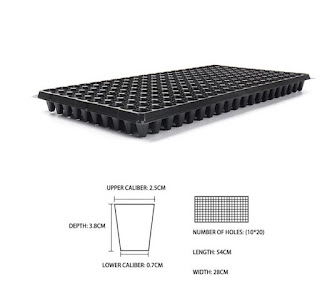Unleashing the Green Thumb: Unlocking the Potential of Planting Trays
Introduction
For gardening enthusiasts and green thumbs alike, planting trays have become indispensable tools in cultivating and nurturing plants. These versatile containers offer numerous benefits, providing an ideal environment for seed germination, efficient space utilization, and enhanced plant care. In this article, we will explore the various ways you can make the most of planting trays to optimize your gardening experience.
Starting Seeds
Planting trays are an excellent choice for starting seeds and giving them a head start before transplanting them into larger pots or directly into the ground. The trays provide a controlled environment that fosters optimal seed germination, offering the right amount of moisture, warmth, and protection. Fill the trays with a seed starting mix or a combination of compost and vermiculite, ensuring adequate drainage. Plant your seeds at the recommended depth, label them for easy identification, and keep them in a warm, well-lit area. As the seedlings emerge, you can gradually expose them to the external environment by removing the tray's cover.
Organizing Transplants
Transplanting seedlings can be a delicate process, but planting trays simplify it by offering a systematic arrangement. Once your seedlings have grown sufficiently, you can easily transfer them from the tray to larger containers or directly into the ground. The modular design of planting seeding trays enables you to arrange seedlings neatly, preventing root entanglement and making the transplantation process more efficient. This organization also facilitates monitoring and watering individual plants, ensuring their healthy development.
Hydroponic Cultivation
Planting trays serve as essential components in hydroponic systems, which allow plants to grow without soil, relying on nutrient-rich water instead. These trays act as containers for the plants, with their bottom section serving as reservoirs for the nutrient solution. By placing the plants in net pots or growing media and positioning them on the tray, the roots can absorb the necessary nutrients from the solution below. This method is highly efficient and conserves water while providing precise control over the plant's nutritional intake.
Creating Microgreens and Sprouts
If you're a fan of fresh and nutritious microgreens and sprouts, planting trays can help you grow them easily. Spread a thin layer of soil or growing medium across the tray, sprinkle the seeds evenly, and moisten them with a gentle spray of water. Cover the tray with a clear lid or plastic wrap to create a mini greenhouse effect. Place the tray in a well-lit area and ensure proper ventilation. Within a few days, you'll witness the vibrant emergence of microgreens and sprouts, ready to be harvested and enjoyed in salads, sandwiches, or as garnishes.
Soil Testing
Planting trays can also be instrumental in conducting soil tests to assess its fertility and pH levels. By filling the tray with soil samples from different areas of your garden, you can easily compare and analyze the composition and quality. This knowledge allows you to make informed decisions regarding soil amendments, such as adjusting pH levels, adding organic matter, or incorporating specific nutrients. Testing the soil in planting trays saves time and effort compared to testing larger garden plots.
Conclusion
Marshine Planting trays offer a myriad of possibilities for gardeners, from starting seeds and organizing transplants to enabling hydroponic cultivation, growing microgreens, and conducting soil tests. These versatile containers streamline the gardening process, providing an environment conducive to optimal plant growth and simplifying various tasks. By incorporating planting trays into your gardening routine, you can unleash your green thumb and unlock the potential of your plants like never before. Embrace the convenience and efficiency of planting trays to nurture your garden and enjoy the rewards of a flourishing, thriving plant kingdom.


评论
发表评论